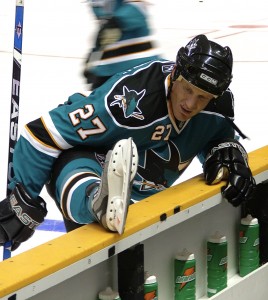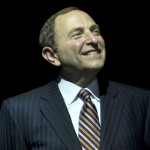Concussion. Head Injury. Upper Body injury. Whatever you want to call it, it’s just as bad and just as harmful to sports, most notably hockey. It’s becoming an epidemic in this great game.
With the recent string of concussions to some of the best hockey players in the world, one has to wonder: What was happening in the past? How could there possibly be this many more concussions in the public eye? It’s a scary question but one that triggers many thoughts when it’s asked.

Are we to believe that there just weren’t as many concussions prior to 2005? The public is not that naïve. Okay, with the speed of the game now and the elimination of the red line prior to the 2005 season, one could explain an increase in concussions. However, the fact that just a few years back the protocols used to diagnosed concussions were vastly different than what we have now, it tells me that the world of medicine wasn’t all that confident in their concussion treatment then, and they probably aren’t very confident in it now either. It’s not their fault. Complex medical issues take decades of research and funding to treat.
What is quite puzzling however is the fact that we saw less severe issues with concussions prior to the lockout and when watching hockey for the last quarter century, the “one week rule” always seemed to be intact for a player who sustained his first concussion. When a player sustained that concussion, usually a doctor would always clear him to play one week after the symptoms ceased.
The one week rule, just like pre-lockout hockey, is gone. Instead we have the ‘I’ word. Indefinitely. It doesn’t matter if your headaches go away the next day, come back one every three days, or symptoms change to some other area of your body. Doctors will not clear you anymore or set any timetables until they feel you’re 100%. Timetables regarding concussions are a thing of the past. It’s not the year 2000 anymore. We are experiencing a medical revolution when it comes to concussion treatment, and no one quite knows where that’s going to lead us.
Another thing that doesn’t happen anymore is players deciding when they want to come back. God knows how many concussions Jeremy Roenick played through in his career. He would likely admit this to you. The 2004 playoffs come to mind. Do you think if he were playing today the doctors would leave Roenick alone if he waved them off? Hell no. Do you think Paul Kariya wasn’t playing through a concussion in the 2003 Stanley Cup Finals after returning to the ice after Scott Stevens knocked him out cold? It’d probably be naïve to think that.

Unfortunately we’re not going to know how badly concussions hurt that era until later in life if god forbid any of these former NHL stars develop any health conditions. Former Flyer Keith Primeau agreed to donate his brain to science when he passes one day. This is what it’s going to take to figure out concussions. Sadly, players waving off trainers was allowed, and the “one week rule” was intact, even if something might not have been right. Clubs and players could take some blame in this, but the most important thing is getting it fixed together now.
Here’s a more controversial question to throw out there: Are concussions being over-diagnosed? Most people would be throwing tomatoes at anyone asking this question, but it’s a fair one.
Here’s a couple points one could use if they were taking this stance:
1.) We’re seeing a lot of generalized symptoms being reported by players that can be caused by other issues, not just concussions. (i.e. minor headaches, nausea, sensitivity)
2.) We’re seeing more and more players diagnosed with concussions who can’t recall where they sustained the concussion, and we have writers and bloggers fishing through hundreds of videos trying to be the first ones to find ‘the hit.’ On a number of occasions people aren’t finding the huge hits that we’ve known to cause concussions in the past.
Do I think a large number of concussions are being misdiagnosed? Probably not. Do I think that some may have been? Absolutely. We’ve seen a few players come back after a day or two of minor headaches or sensitivity. One player told me this season that he never thought he had a concussion, but the team trainer wasn’t going to allow him back on the ice even though he wanted to be back out there.
The focus is on concussions right now, as it should be. When the focus is on concussions you’re going to have people relating any symptom they’re having to a concussion, even if it’s not one. It’s like a placebo effect in a way. That’s where the term ‘concussion-like symptoms’ came from.
Either way, it’s a good idea that the NHL and their clubs are playing it safe when it comes to these injuries. Even if it wasn’t a concussion and it was just the flu or a headache or a temporary illness, it’s a good idea to treat it like it might be. A mistake in the other direction could mean career long consequences for a player.

One thing that is aggravating is internet doctors, former players, and esteemed media members trying to make a case for the end of fighting, making 75% of contact in the NHL illegal, and blaming Gary Bettman and the NHL for being short sighted. The only thing the NHL can change regarding concussions is how the game is played and hope for better results. They can change the rules if they felt that would lower concussions. Former Flyers great Eric Lindros said to me in an interview earlier this season that he would be in favor of a couple rule changes he felt would alleviate concussions that were happening due to the speed of the game.
“My thought would be putting the red line back in would alleviate a lot of this,” Lindros stated. “Possibly widening the ice 5 feet on either side would be a pretty good idea, too.”
If the critics want the NHL to change the rules such as the ones Lindros suggested, that’s a fair argument. But for those asking the NHL to put a scientist cap on and just yelling “Do Something!” with no real solution to offer themselves, that just makes them look dumb, even if they’re a former player that experienced concussions. The number one rule in the business world is, “Don’t complain unless you have a solution of your own to offer.”
Hey, if you want to rip the NHL for not changing the rules strictly because you think they won’t change them for the entertainment factor (speed, flow), or money, all power to you. Just don’t expect them to be brain scientists.
It’s hard to understand the hysteria out there regarding concussions when it’s directed at specific individuals or organizations as borderline personal attacks. There’s a lot of so called “concussion experts” out there. The data is so unknown at this point that concussions are like the NHL’s version of global warming. The NHL knows it’s a problem. They’re not that ignorant, even if they aren’t giving you that warm and fuzzy feeling of inviting you into their club to discuss the concussion issues.

People can play the blame game all they want. People can rip the NHL. People can rip doctors. People can rip medical schools. But the truth is only that it is what it is. Gary Bettman is a guy that doesn’t like to let people into his mind. He’s a great lawyer. I’ve spoken with him on many occasions and while I don’t know him personally, I get the feeling based on what I know of him that he is already aware of this threat and is speaking to the top experts in the field to make sure they have the most effective treatment possible, even if he’s not discussing it with the media or the public.
With so many unanswered questions, if anyone out there is in medical school right now studying to enter the neurology field, take note: the NHL needs your help, even if they aren’t admitting it right now. Think about taking up shop in a specialty that can only improve from here: concussion treatment.
Interesting – thanks for the note, Mark
We’re seeing a lot of generalized symptoms being reported by players that can be caused by other issues, not just concussions. (i.e. minor headaches, nausea, sensitivity)
These overlapping symptoms of temporal mandibular joint dysfunction can be confused with classic concussion. Many Bruin and NHL,NFL players who diagnose with TMD have found relief.
A corrective orthodontic type of mouth guard used by the 08 Hershey Bears, reducing these types of jaw related symptoms could help in curbing many “events”. The Bears had a drastic reduction compared to the prior year. While not all concussion is not related to the jaw, many facial blows result in trauma to the temporal mandibular joint and many believe this trauma is translated to the temporal lobe, exactly where CTE is found. The U.S. Army is now pursuing this research path. The NHL and NFL should follow suit. http://www.mahercor.com has much more.